7-DAYS ADVENTUURE
KILIMANJARO
MACHAME ROUTE
Tanzania
Overview of 7 Days MACHAME route
The Machame Route 7 days is one of the most scenic and popular ways to climb Mount Kilimanjaro. Known as the Whiskey Route for its demanding yet rewarding path, it is ideal for adventurous hikers seeking a real mountain challenge. This route offers a high summit success rate thanks to its excellent acclimatization profile with plenty of walk-high and sleep-low opportunities. Trekkers pass through five distinct climate zones, from rainforest and heath to alpine desert and arctic summit. Key highlights include the Shira Plateau, Lava Tower, Barranco Wall, and sweeping views of Kilimanjaro’s southern ice fields. The climb begins at Machame Gate and ends with a descent via the Mweka Route, giving trekkers a full range of landscapes. The journey starts in Moshi and finishes at Uhuru Peak (5,895m), the highest point in Africa. This route is perfect for hikers looking for challenge, scenery, and a strong chance of reaching the summit.
Trip highlights
- High Summit Success Rate Benefit from the route’s over 98% summit success rate, thanks to its gradual ascent, which gives you ample time to acclimatize.
- Shira Plateau – Trek across this vast, ancient volcanic caldera with sweeping views of Kibo Peak. The high-altitude moorland landscape feels like another planet!
- Barranco Wall Challenge – Conquer this thrilling (but non-technical) 257m rock scramble. The adrenaline rush and panoramic views make it a trekker favorite!
- Southern Ice Fields Walk beneath Kilimanjaro’s stunning glaciers on the southern slopes—an awe-inspiring view of the mountain’s remaining ice caps before reaching the summit.
- Fully Carbon Offset Rest easy knowing your trip is fully carbon offset, helping to preserve the environment you’re exploring.
Contact our TZ team
Our local team
Ready to plan a once-in-a-lifetime adventure in Tanzania?
Get in touch with us — our team is always here to help you every step of the way.
GALLERY

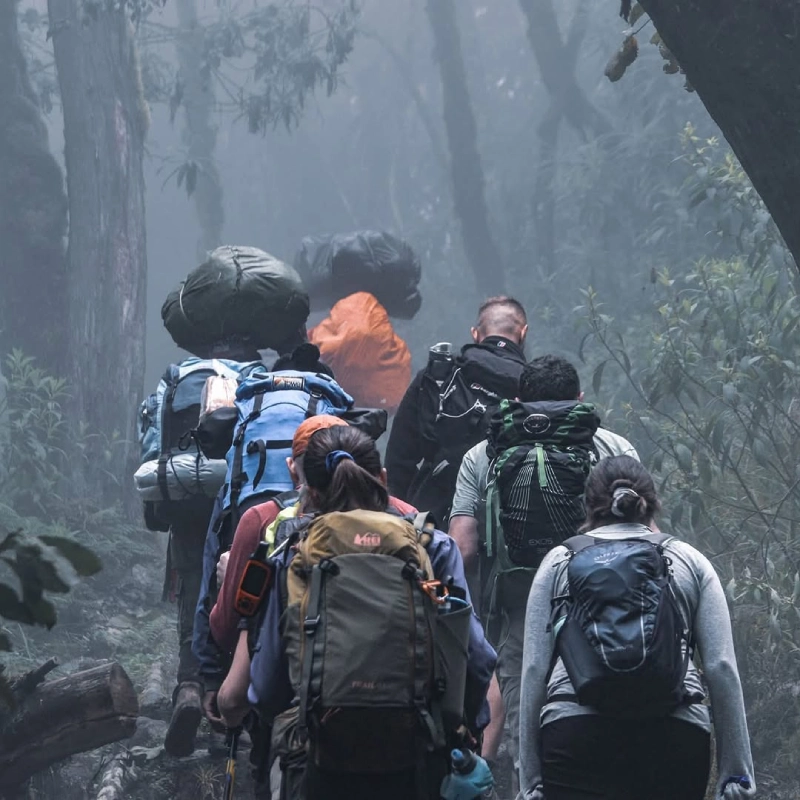
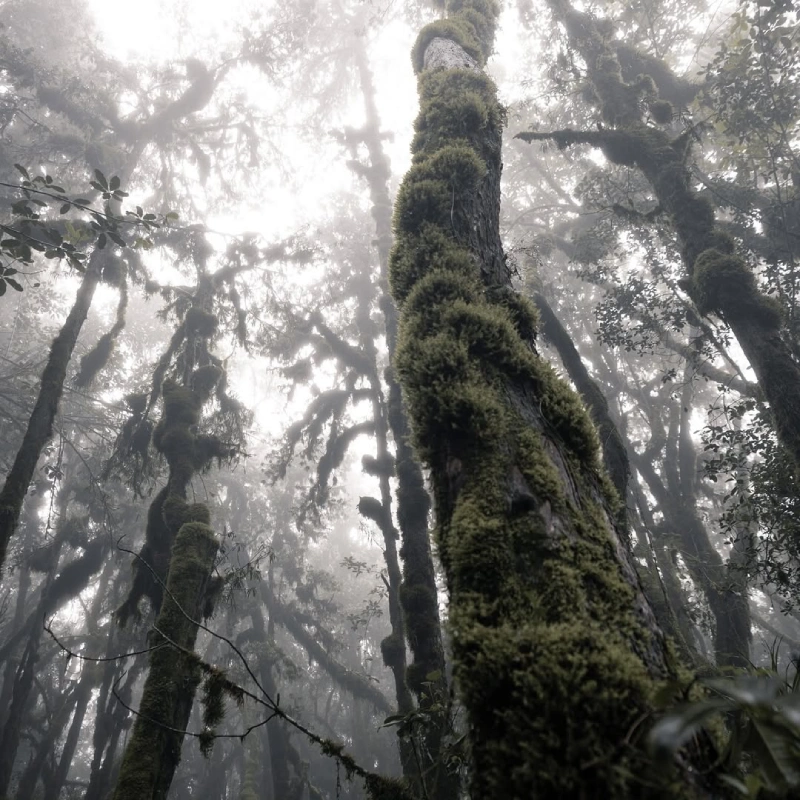
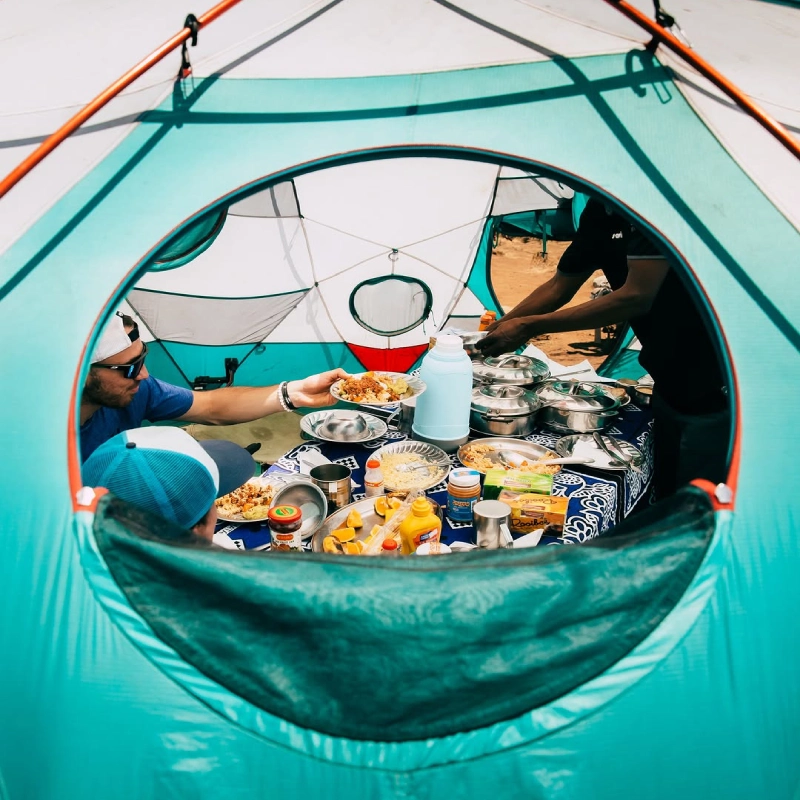
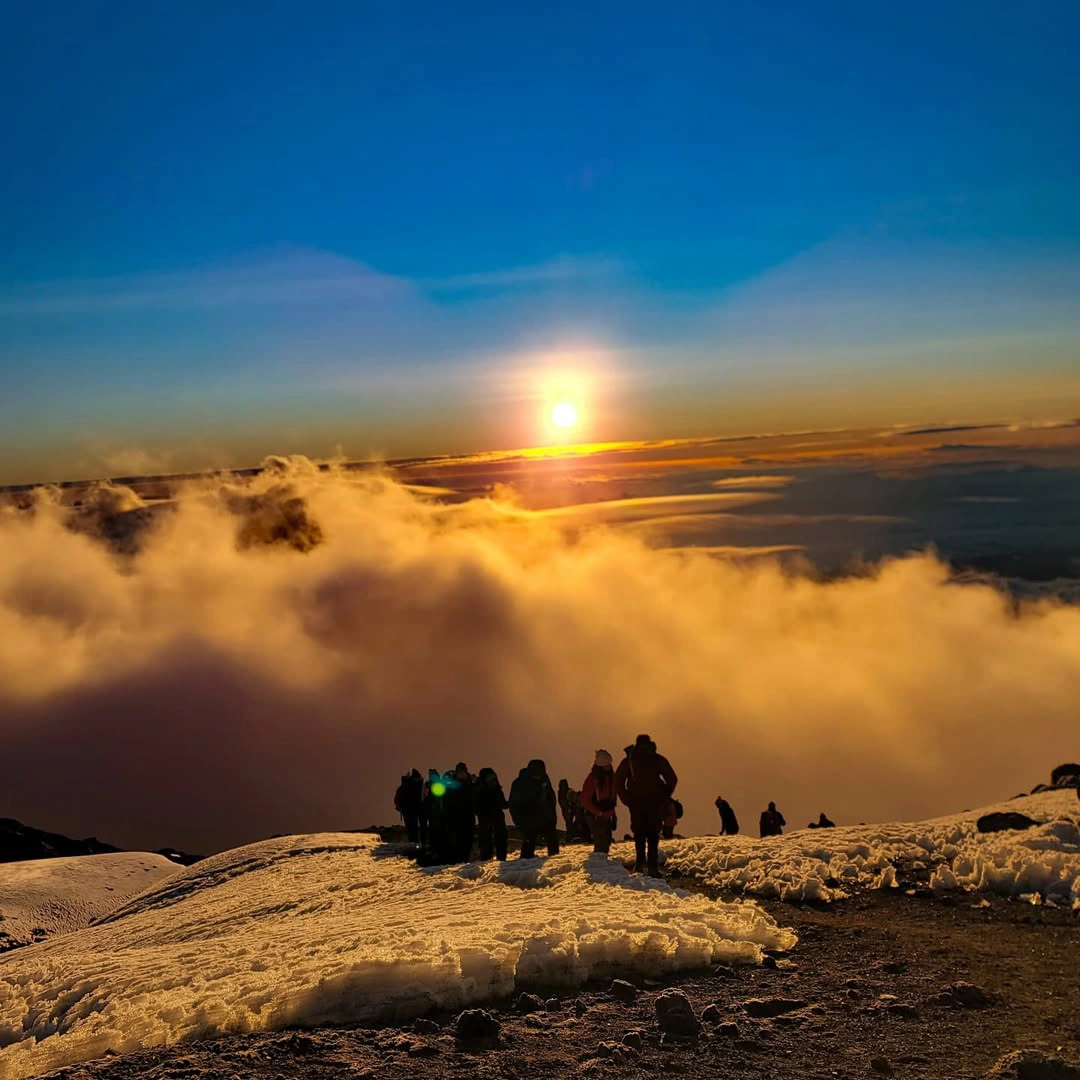
Machame Route Detailed Itinerary
DAY
1
Arrival
Once you arrive at Kilimanjaro International Airport, a friendly representative from Hiking Kilimanjaro will be waiting to greet you. Depending on your itinerary, they will transfer you to your comfortable hotel in Moshi or Arusha. The hotel offers everything you need to relax and recharge before your climb—cozy rooms, hot showers, reliable Wi-Fi, a refreshing swimming pool, and attentive staff ready to assist you.
Later in the evening, you’ll meet with our mountain guides and trip managers for a detailed Kilimanjaro trekking briefing. They’ll go over the route, check your gear, and ensure you’re fully prepared for your Mount Kilimanjaro adventure.
- Transport: Private transfer
- Accomodation: Hotel
DAY
2
TREKKING FROM MACHAME GATE TO MACHAME CAMP
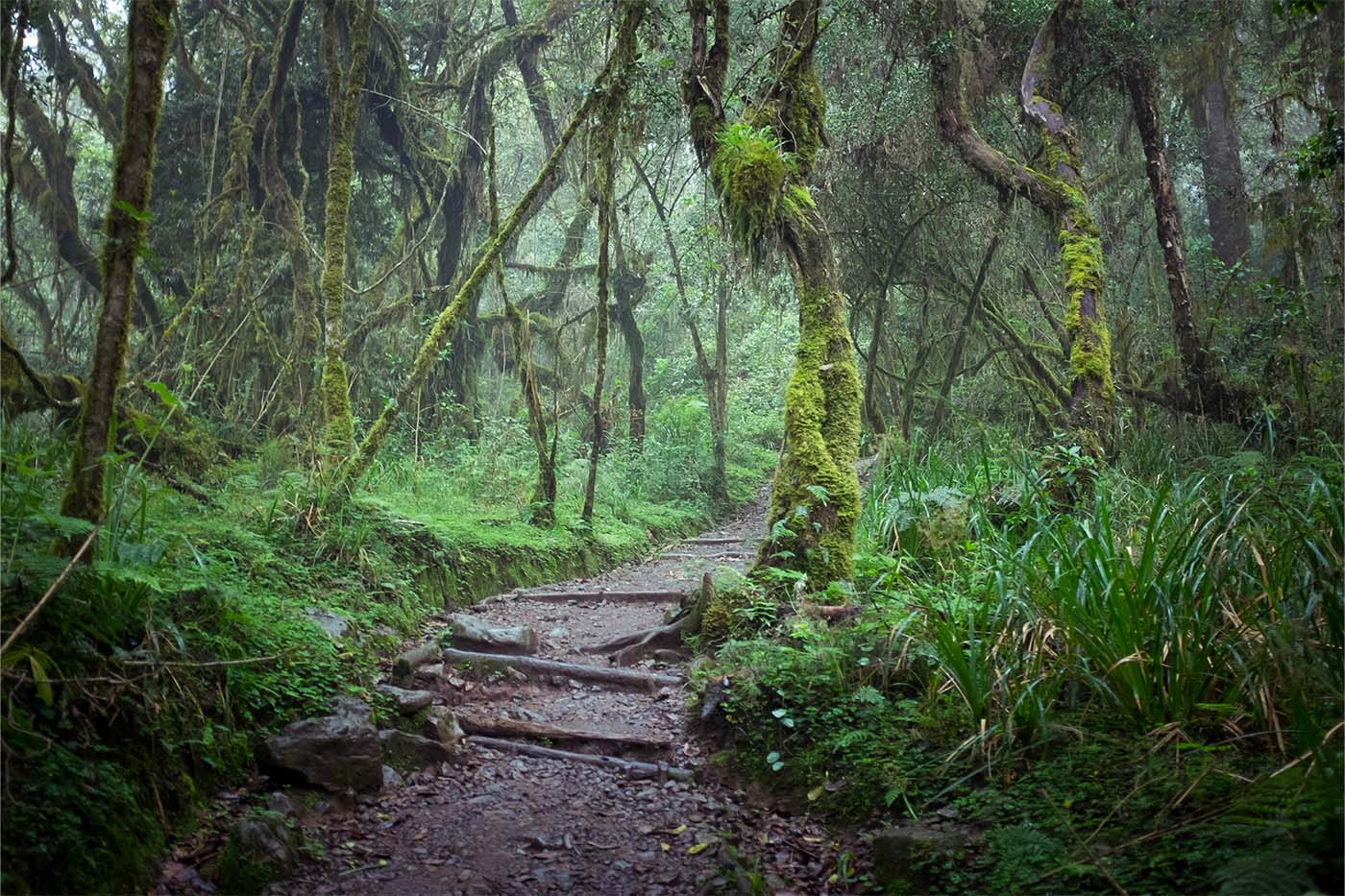
On the first morning of your climb, your certified mountain guide and dedicated Kilimanjaro support crew will arrive at your hotel to meet you in person. Our guide will conduct a final pre-trek briefing to review your route, gear, and expectations for the day. Afterward, you will drive to the Machame Gate, which is the official entry point to Kilimanjaro National Park and the starting point of the famous Machame Route.
Upon arrival at the gate, your guide will assist you with all necessary formalities, including obtaining climbing permits, registering with Kilimanjaro Search and Rescue, and conducting final gear checks. Once everything is in order, you will officially begin your Mount Kilimanjaro trek with a hike through the lush, green rainforest zone.
Expect a scenic walk surrounded by thick vegetation, unique flora, and the sounds of exotic birds and monkeys. However, be prepared—tropical rain showers are common in this region, especially during the earlier parts of the day. We strongly recommend packing a waterproof rain jacket, a rain cover for your backpack, and a set of dry clothes to change into at camp.
Important Acclimatization Advice for Your First Day at Altitude
Today marks your first ascent to a significant altitude. From this point forward, it’s essential to prioritize your acclimatization to help prevent altitude sickness. Follow these important guidelines:
1. Stay Well Hydrated: Aim to drink at least 4 liters of bottled water throughout the day. Take small sips regularly instead of consuming large amounts all at once.
2. Consider Altitude Sickness Medication: Many climbers choose to take high-altitude medication, such as Diamox, before starting their trek. That can help minimize symptoms like headaches and nausea. Our team will explain how and when to use it during your personalized travel briefing. Always consult your doctor before your trip to ensure it’s safe for you.
3. Listen to Your Body: As your body adjusts to the altitude, you may experience symptoms such as headaches, fatigue, nausea, or difficulty sleeping. These are common during the first nights on the mountain. If you feel unwell, you will need to inform your guide immediately—our crew will closely monitor your symptoms and will take all necessary steps to ensure your safety throughout the climb
- Elevation: 1830m/6000ft to 3050m/9950ft
- Distance: 11km/7mi
- Hiking Time: 5-6 hours
- Habitat: Montane Forest
- Meals: Lunch and Dinner
DAY
3
HIKING FROM MACHAME CAMP TO SHIRA CAMP

After enjoying a hearty breakfast at Machame Camp, you will begin your trek toward Shira Camp, the second high-altitude campsite on the Machame Route. As you ascend today, you will leave the dense, misty rainforest zone behind and enter the moorland and heather zone, where the landscape opens up dramatically.
For the first time on your Mount Kilimanjaro adventure, you will be treated to breathtaking panoramic views of the Shira Plateau, one of the oldest geological formations on the mountain. The terrain will gradually shift to more rugged volcanic rock, and although the trail is not technically challenging, the gain in altitude will become more noticeable. You may begin to feel the effects of thinner air, so it will be essential that you listen to your body and follow your guide’s recommended pace. Maintaining a slow and steady rhythm is crucial for successful acclimatization.
Once you reach Shira Camp, you will rest and enjoy a warm lunch prepared by our support crew. In the afternoon, your guide will lead you on an important acclimatization hike towards Lava Tower Camp, gaining approximately 400 meters (1,312 feet) in elevation. This hike plays a key role in helping your body adjust to the increasing altitude.
After reaching the turnaround point, you will descend back to Shira Camp, where a hot dinner will be waiting to refuel and warm you after a long day on the trail.
Please Note:
The acclimatization hike, although relatively short and easy, is a critical step in your overall success on Kilimanjaro. Taking these hikes seriously will significantly increase your chances of reaching the summit and reduce the risk of altitude sickness. Our team will guide you every step of the way to ensure that your body gradually adapts to the mountain’s changing environment.
- Elevation: 3050m/9950ft to 3850m/12,600ft
- Distance: 5km/3mi
- Hiking Time: 4-5 hours
- Habitat: Moorland
- Meals: Breakfast, Lunch and Dinner
Professional Guides
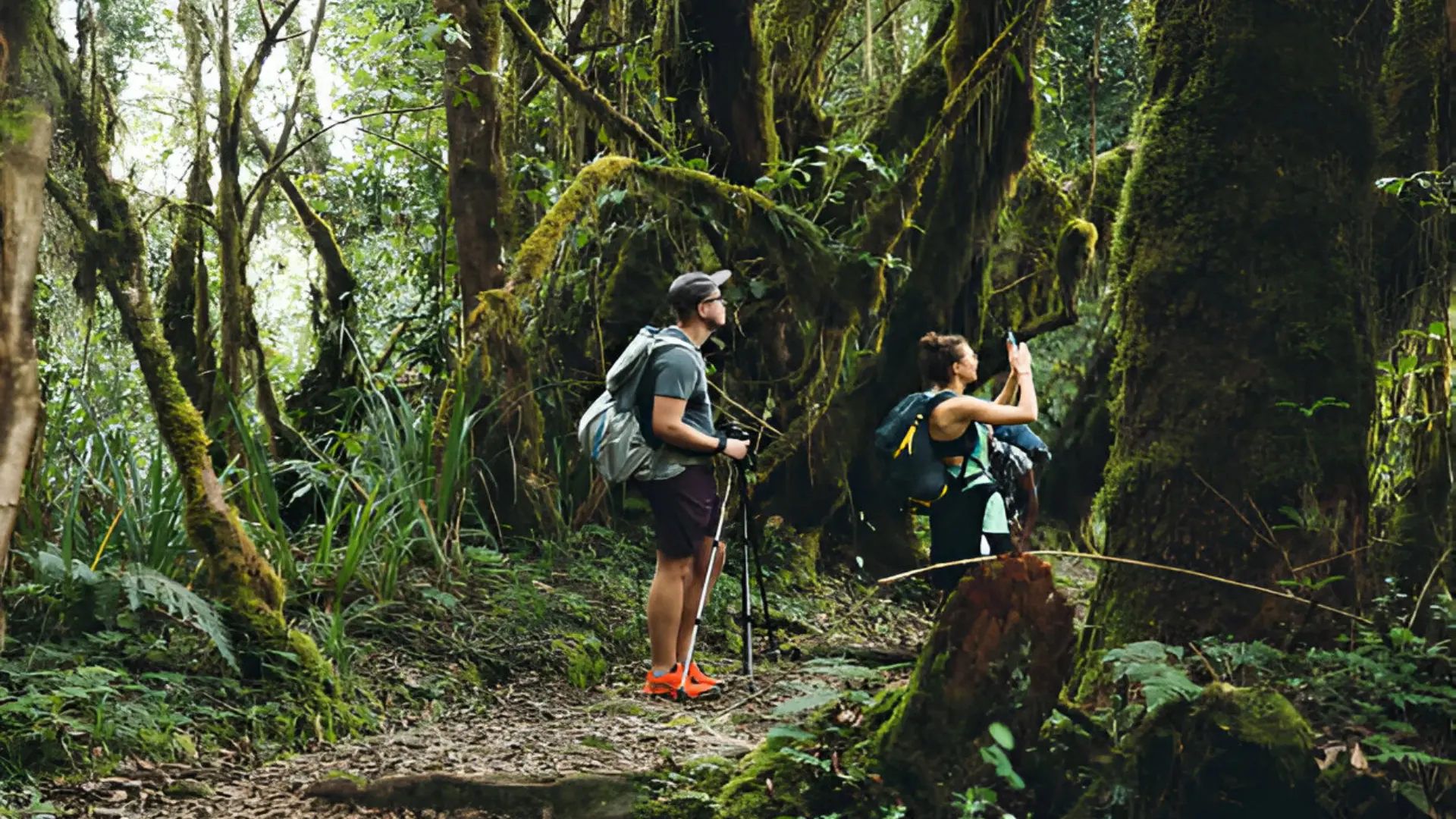
- 10+ years of Experience
- Wilderness First Responders
DAY
4
TREKKING FROM SHIRA CAMP TO THE LAVA TOWER AND DESCENT TO BARRANCO CAMP
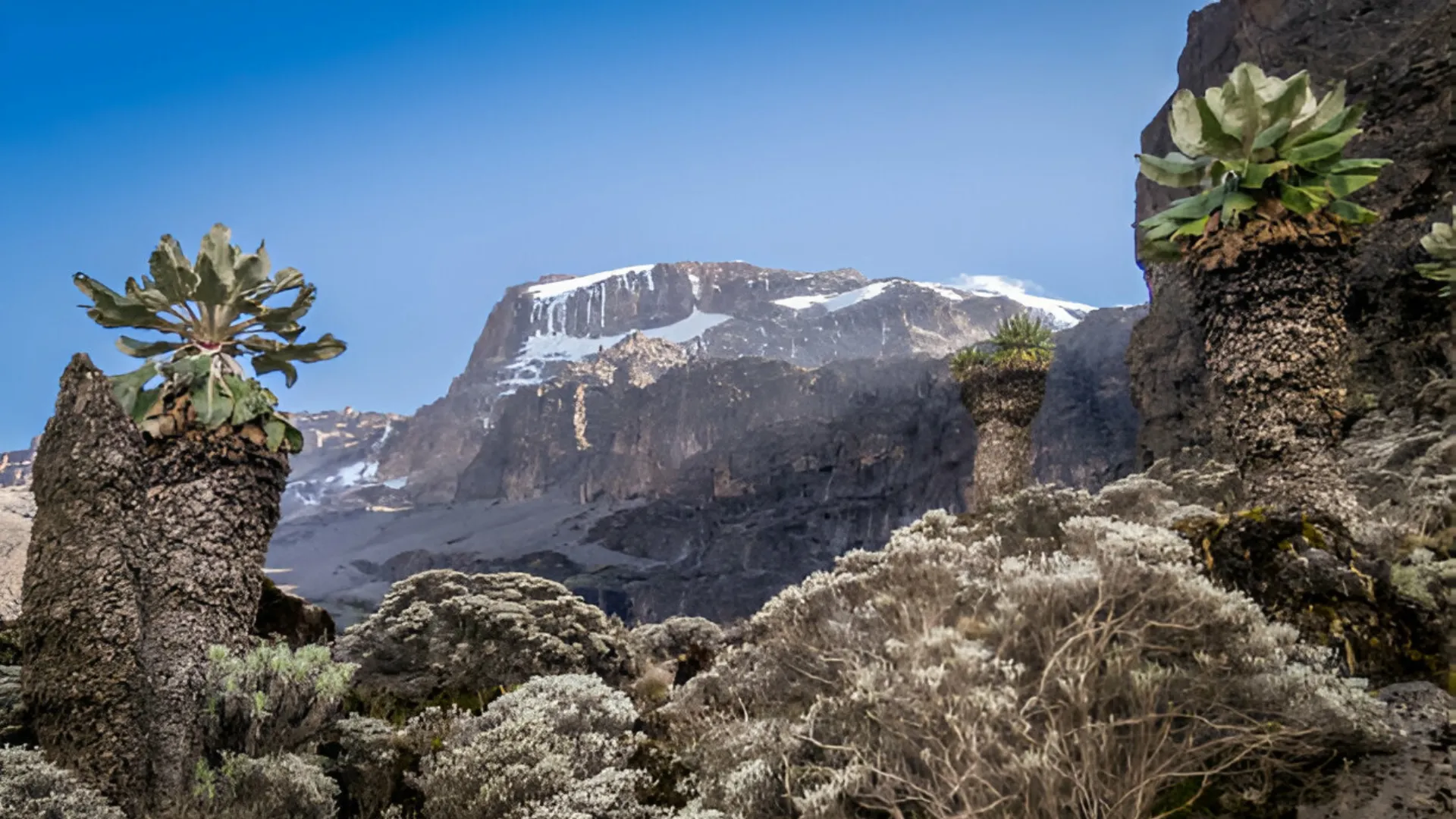
After finishing a warm breakfast at Shira Camp, you will continue your Kilimanjaro ascent by heading toward one of the most important acclimatization points on the Machame Route—the legendary Lava Tower, standing tall at 4,600 meters (15,088 feet) above sea level.
This part of the trek will challenge you with a series of steady ascents and descents as you move through the alpine desert zone. The landscape will become increasingly rugged and barren, offering a stark contrast to the lush moorlands you passed earlier. While this stretch of trail is incredibly scenic, it can also be physically demanding. The higher altitude may cause some discomfort, such as headaches or fatigue, but spending time at Lava Tower is essential for acclimatization.
To maximize your time at high elevation, your group will stop at Lava Tower Camp for a well-earned lunch break. You will spend at least 1–2 hours at this altitude, allowing your body to adjust gradually to the thinner air. This strategic stop greatly increases your chances of a successful summit later in the trek.
After lunch, you will descend gradually to Barranco Camp, located at 3,976 meters (13,044 feet). This descent is not only easier on the lungs and legs but also reinforces the “climb high, sleep low” acclimatization strategy—proven to help climbers adjust to Kilimanjaro’s extreme elevations.
As you approach camp, you’ll come face-to-face with the imposing Barranco Wall—a massive cliff that rises dramatically above the valley floor. Despite its appearance, there’s no need to worry. Although it looks intimidating, the Barranco Wall features a well-established, non-technical trail that you will climb the following day under the guidance of your experienced trekking team.
- Elevation: 3850m/12,600ft to 4000m/13,000ft
- Distance: 10km/6mi
- Hiking Time: 5-6 hours
- Habitat: Semi-desert
- Meals: Breakfast, Lunch and Dinner
DAY
5
HIKING FROM BARRANCO CAMP TO KARANGA CAMP
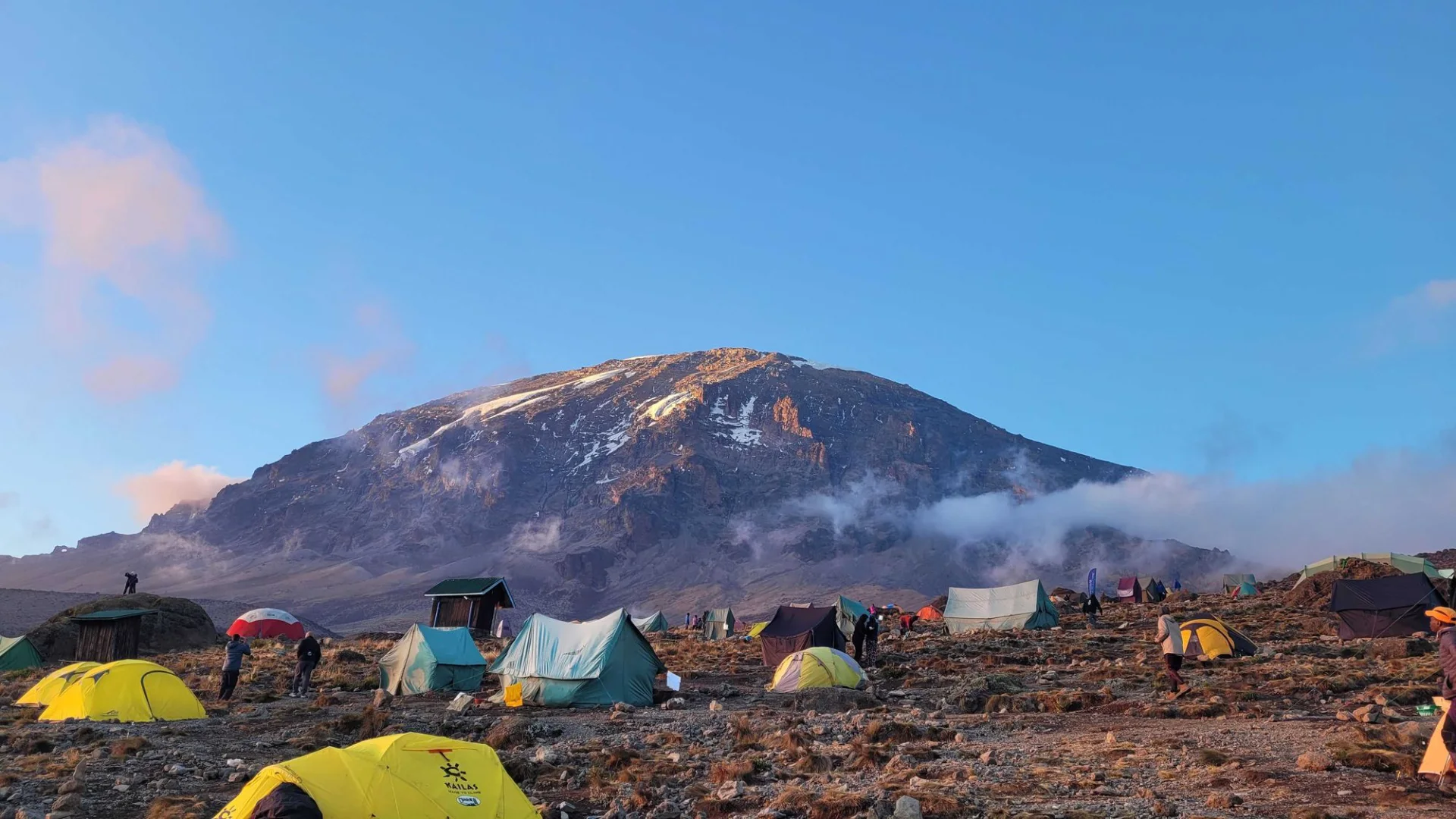
On this day it is best to make an early start to avoid crowding on the way up Barranco Wall. Despite the Wall’s seemingly daunting height and steepness the actual climb is rather simple and takes only an hour or so to complete. The top of the wall provides a great photo opportunity with Kibo Peak as the backdrop.
The next part of the day is rife with ups and downs and your guides will choose the best pace for individual trekkers. A lunch break at Karanga Camp will be followed by an acclimatization hike in the direction of Barafu Camp with its highest point of the hike being 3,995 m /13,104 f. The group then hikes back to Karanga Camp for the night.
- Elevation: 4000m/13,000ft to 4050m/13,250ft
- Distance: 5km/3mi
- Hiking Time: 3-4 hours
- Habitat: Alpine Desert
- Meals: Breakfast, Lunch and Dinner
DAY
6
HIKING FROM KARANGA CAMP TO BARAFU CAMP
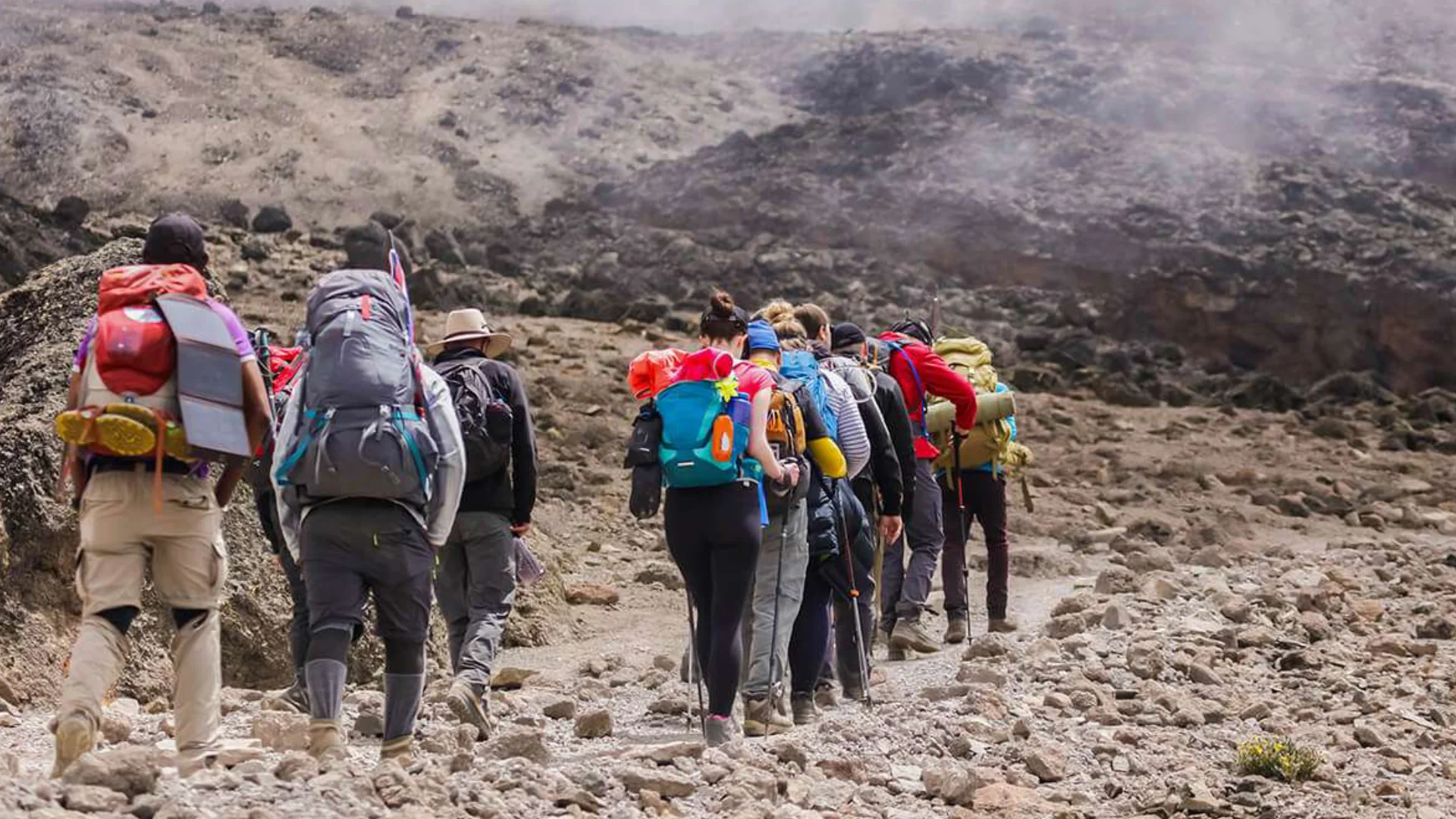
After breakfast, you will begin your way to Barafu Summit Camp. Our team will set up a camp for you ahead of time, including tents and sleeping bags, so you can relax upon arrival. After regaining strength, you have to complete an acclimatization climb towards the intermediate Kosovo Summit Camp with its highest point being 4,870 m /15,974 f and then back to Barafu Camp, where you will be served a hot dinner. It is better to spend the remainder of the day resting and sleeping before the night summit.
- Elevation: 4050m/13,250ft to 4700m/15,350ft
- Distance: 4km/2mi
- Hiking Time: 3-4 hours
- Habitat: Alpine Desert
- Meals: Breakfast, Lunch and Dinner
DAY
7
ASCENT TO UHURU PEAK AND DESCENT TO MILLENNIUM CAMP

Your team will begin the summit attempt to Uhuru Peak in the early hours of the night, typically around midnight. After enjoying a light snack and conducting a final gear check at Barafu Camp, you will embark on your journey to Uhuru Peak, the highest point in Africa, standing at 5,895 meters (19,336 feet).
While the trail itself is straightforward and does not require any mountaineering experience, the true challenge lies in the extreme altitude and freezing temperatures. Every step will require focus and determination, as even simple movements can feel exhausting due to the thin air at high elevations.
To ensure your safety and well-being during this critical phase of the trek, each pair of climbers will be accompanied by a dedicated guide. These experienced professionals will closely monitor your physical and mental condition throughout the ascent, offering support, encouragement, and medical attention if needed.
As the sun rises, you will reach Uhuru Peak, the iconic summit of Mount Kilimanjaro. Here, you will stand on the Roof of Africa and take in panoramic views of glaciers, the crater rim, and the endless horizon—an unforgettable reward for your endurance and perseverance.
If conditions permit and you feel up to it, you may take a short detour to visit the nearest glacier, a surreal and stunning reminder of Kilimanjaro’s natural beauty.
After celebrating at the summit and capturing your victory photos, you will begin the descent back to Barafu Camp. Upon arrival, you will take a well-deserved two-hour rest to recover and refuel with a warm meal. In the afternoon, your team will continue the descent to Millennium Camp, which is located at a much lower and more oxygen-rich altitude. This drop in elevation will help your body recover and alleviate symptoms of altitude fatigue.
PLEASE NOTE:Don’t forget that 90% of all accidents occur during the descent, including most broken arms and legs. Please pay attention to your feet, as there is a high risk of damaging your toenails.
- Elevation: 4700m/15,350ft to 5895m/19,340ft
- Down to 3090m/10,150ft
- Distance: 5km/3mi up / 13km/8mi down
- Hiking Time: 5-7 hours up / 5-6 hours down
- Habitat: Stone scree and ice-capped summit
- Meals: Breakfast, Lunch and Dinner
DAY
8
DESCENT FROM MILLENNIUM CAMP TO MWEKA CAMP

The Millenium Camp is situated in a tropical rainforest. When you wake up, you will feel relief from the reduction of altitude and the satisfaction of reaching the summit. After a warm breakfast, you will head for the park’s exit: Mweka Gate (1,640 m / 5,380 ft). After your descent the whole group will gather to congratulate you, followed by offering you a chance to share your opinions on the climb in the guestbook. Lastly, we will present you with your commemorative certificates in our office and provide you with a transfer back to the hotel.
- Transport: Private transfer
- Accomodation: Hotel
DAY
9
Millennium Camp to Mweka Gate
Rest in the hotel and transfer to the airport.
PLEASE NOTE: Hotel check-out is at 11:00 AM. In case you need a late check-out because of an evening flight, there is the option to extend your hotel stay for an extra fee.
- Transport: Private transfer
- Accomodation: Hotel
DETAILED PRICE FOR MACHAME ROUTE
Our classic adventures are what the majority of climbers are looking for. The combination of great comfort and high safety standards makes our classic Kilimanjaro hikes enjoyable and memorable. This is the most popular option among our clients.
This climbing package includes everything that a climber may need for the hike – our experienced mountain crews, high-quality group equipment, nutritionist-designed meals. Our safety protocols, though, are the same for all our hiking adventures – only the guides with Wilderness First Responder certification are assigned to lead a party. Other safety measures include a supply of oxygen cylinders, complete medical kits and compulsory medical check-ups (two per day).
The progress of each trekking party is tracked with GPS device. You may share the link with your family and friends, who will be able to monitor your progress in a real-time mode.
Before and after the adventure you will stay in a good hotel with caring staff, hot water, reliable Wi-Fi, restaurant and swimming pool.
Price For Machame Route
PRICE
1 pax
2 pax
3 pax
4 pax
5 pax
6 pax
7 pax
8 pax
$ 2,216 USD*
$ 2,116 USD*
$ 2,071 USD*
$ 2,061 USD*
$ 2,021 USD*
$ 2,018 USD*
$ 2,010 USD*
$ 1,999 USD*
PRICE
1 pax
2 pax
3 pax
4 pax
6 pax
6 pax
7 pax
8 pax
Per Person
$ 2,216 USD*
$ 2,116 USD*
$ 2,071 USD*
$ 2,061 USD*
$ 2,021 USD*
$ 2,018 USD*
$ 2,010 USD*
$ 1,999 USD*
- CLIMBING COST INCLUDES
Our Kilimanjaro packages cover all transfers outlined in the program. When you arrive at Kilimanjaro, one of our drivers will pick you up in a spacious and comfortable Toyota Alphard and take you to your hotel. Our cars have large trunks that can accommodate plenty of luggage. Inside you'll find complimentary bottled water (custom-ordered by Hiking Kilimanjaro), a Wi-Fi hotspot, and wet wipes for your convenience. All our cars undergo regular examination and maintenance by our in-house team of technicians.
Our driving team consists of experienced and knowledgeable drivers, all of whom speak fluent English.
For the transfer to the trailhead of your climbing adventure, we will use Toyota Hiace or Coaster, which are better suited for navigating the wilderness terrain en route to Mt. Kilimanjaro. These cars are built to handle rough trails and ensure your safety.
At the end of your journey, we'll also provide you with a return transfer to the Kilimanjaro International Airport. With our comprehensive package, you can rest easy and enjoy the journey without concerns about your transportation.
The night before the climb and the night following the descent, you will be accommodated in a 3* hotel in the area of Moshi Town. By default - shared double occupancy room unless you order a single supplement. In your hotel, you will find everything a traveler needs: professional staff, a restaurant, a swimming pool, comfortable rooms with mosquito nets, laundry service, and complimentary Wi-Fi.
By default, our packages include bed and breakfast accommodation. We also offer half-board and full-board upgrades at an additional cost.
Note:You will be sharing a room with your travel companion, or, if traveling solo, with a same-sex traveler. If you prefer to have a single room, please order a single supplement as soon as you can, as our hotels often have many guests, and the rooms may be fully booked by the time of your arrival. Also, should you decide to descend earlier than planned, a charge for all extra nights spent in our hotels will apply. Contact your travel consultant to book a single room.
On the day before the climb, our managers will meet you in your hotel for an orientation briefing, and our car will pick you up for the start of your Kilimanjaro adventure.
Hiking Kilimanjaro offers a Kilimanjaro adventure with all the necessary amenities for a safe and comfortable camping experience.
Durable Kilimanjaro tents, custom-designed by UK-based engineers
Developed to withstand strong winds and heavy rains, these 4-season tents provide a cozy atmosphere. Tent entrances are easy to open and close and provide a comfortable buffer zone. Rest assured that the ever-changing equatorial weather on Kilimanjaro will not disturb your much-needed sleep.
As of today, these tents are the best choice for the Kilimanjaro adventure, and Hiking Kilimanjaro is the only company to have them.
Please note: by default, you'll be sharing a tent with your travel companion or other same-sex co-hiker (unless you've ordered a private hike). Though designed for three people, each Hiking Kilimanjaro tent sleeps only two hikers on our adventures. Single supplements are available at an extra charge. Contact your manager for more details.
Thick sleeping mats
Our hikes include 3-inch sleeping mats produced by our company’s tailor shop, which is located right at our Arusha Base Office.
Camping tables with stainless steel cutlery and ceramic crockery
They are served and cleaned by a dedicated kitchen crew at each meal. At Hiking Kilimanjaro Travel, we are committed to reducing plastic waste and never using disposable tableware.
Spacious mess tents
Produced for Hiking Kilimanjaro by RedFox, a reputable brand and manufacturer of outdoor equipment, our dining tents are strong, wind- and rainproof, allowing for a comfortable dining and socializing experience, even in bad weather.
Foldable camping chairs
Durable and comfortable chairs that provide excellent back and arm support, they’ll make evening get-togethers in the mess tents a pleasant pastime with your teammates. Grab one and enjoy an epic sunset from the edge of the camp!
Handwashing stand
Our camp crew regularly fills it with hot water so that you can keep your hands and face clean.
The camp managers arrive at the camping grounds hours ahead of your group to pick the most picturesque location at a distance from other hiking groups. They also keep a close eye on the tents and other camping equipment to ensure everything runs smoothly. Each camp manager carries a repair kit in case quick maintenance is needed, although our expedition managers inspect each tent before the expedition starts, making such situations unlikely.
Our mountain chefs and waiters will take care of preparing and serving your breakfasts, lunches, and dinners throughout the adventure. The menu has been designed in consultation with a professional dietitian to ensure that our meals are both delicious and energy-rich, providing hikers with the necessary nutrition.
At Hiking Kilimanjaro, we understand that everyone has unique dietary needs. That's why we offer delicious vegetarian, vegan, gluten-free, lactose-free, and other types of meal plans for our mountain adventures. Just let your manager know, and our mountain chef will be ready to prepare a meal that meets your requirements. Best of all, switching to a special meal plan won't cost you a thing.
For example, for breakfast, you can expect to enjoy porridge, vegetables, eggs, sausages, sweet potato, spinach cooked in a local fashion ("mchicha"), and coffee or tea. For lunch, we usually serve various soups (butternut, tomato, leek, vegetable, beef); spaghetti; stews; avocado salads; mashed potato; fried chicken with coconut, tomato, garlic and other sauces; minced meat in tomato sauce, and other popular international and local meals.
Similarly, for dinner, you can expect a soup; vegetable salad (locally styled "Kachumbari"); Mexican salad with tomatoes, corn, and onion, avocado; a juicy stew (such as bamia stew); fried vegetables; various main dishes with chicken, beef or fish. All meals are served with tasty sauces, and extra seasonings are always available on the table. After each meal, our waiters serve fresh local fruits, such as mangoes, oranges, pineapple, and bananas, to give hikers a vitamin boost.
We use organic, locally grown fruits, vegetables, and meat from neighboring farms to supply our trips. Our team rigorously checks each provider to ensure that it has a certification from the Tanzania Food and Drugs Authority (TFDA). Hiking Kilimanjaro also prefers to choose small local farms instead of large agricultural companies. This way, we ensure that all produce is always fresh and organic and that our expeditions provide a meaningful impact on the local economy.
Our mountain chefs will prepare all meals during the expedition, except for lunch on the first day of your trip, which you will have after entering the park and before reaching the first camp where we will set up our kitchen. Our chefs will prepare this first lunch, and we will pack it for your adventure in sturdy compostable packaging from Vegware, our UK-based supplier of eco-friendly food packaging.
When evaluating the quality of our meals on Kilimanjaro, please keep in mind that our teams prepare them in very challenging conditions. Our mountain chef prepares meals in a camp kitchen, using a camping gas oven with an electric torch for lighting. At times, weather conditions can be harsh, with wind and rain, and during certain months, it can be quite cold. While our mountain chef strives to create delicious and visually appealing meals, the unpredictable weather and challenging camping conditions may occasionally impact the quality and appearance of our dishes. We work tirelessly to maintain a high level of performance in such a demanding environment.
Meet Your Kilimanjaro Dream Team: Expert Guides, Real Stories, and Unmatched Safety
When you climb Mount Kilimanjaro with us, you’re not just following a path—you’re being led by some of the most experienced and passionate mountain guides in Tanzania. Our Kilimanjaro guides aren’t just professionals—they’re legends on this mountain.
🧭 Deep Experience You Can Trust
Every one of our Kilimanjaro guides has a minimum of seven years of hands-on mountain experience, with expert knowledge of the terrain, wildlife, and weather patterns.
🚑 Certified Wilderness First Responders (WFR)
Safety is non-negotiable. Every mountain guide is a certified Wilderness First Responder, trained to handle medical emergencies in remote conditions. This international certification—issued by Wilderness Medical Associates—ensures you’re in capable, well-prepared hands every step of the way.
📖 Legendary Storytellers
Our guides bring Kilimanjaro to life. Whether it’s ancient legends, cultural tales, or insights about the mountain’s unique plants, animals, and history, you’ll come away with more than just memories—you’ll leave with a deeper connection to the land. And when you’re ready for silence and reflection, they’ll step back, giving you space to take it all in.
🏕 A Strong Support Crew Behind the Scenes
Behind every great summit is a hard-working team. Our porters, camp managers, and chefs form the backbone of your expedition. They’ll set up camp before you arrive, collect fresh water from the mountain, and ensure every meal is both nutritious and delicious—because fuel matters on the way to the top.
❤️ Fair Treatment, Happy Team
We believe in doing things right—not just for our guests, but for our team. That’s why we pay the highest wages in the Tanzanian trekking industry and open individual bank accounts for each crew member to ensure fair, transparent compensation. A respected, well-treated team is a motivated one—and you’ll feel that positive energy every day on the trail.
🌟 The Reason We’re #1 on TripAdvisor
Our guiding team earns glowing reviews day in and day out. Their professionalism, warmth, and commitment to excellence are why we’re proud to be the top-rated Kilimanjaro trekking company on TripAdvisor.
We carry bottled oxygen supplies for each Hiking Kilimanjaro expedition. The guiding team uses it to make the high-altitude acclimatization process easier and prevent acute mountain sickness (AMS). Our guides administer bottled oxygen as soon as a climber develops the first signs of AMS, and that typically stabilizes the oxygen saturation, allowing them to continue the adventure.
At Hiking Kilimanjaro, we never run short on oxygen supplies. In the unlikely event of a crisis requiring larger amounts of oxygen for one of our teams, other Hiking Kilimanjaro teams from the same camp will always come to help and share their supplies. As the largest operator on Kilimanjaro operating 15% of all on Kilimanjaro, we have multiple Hiking Kilimanjaro teams located in different camps at the same time. Besides, we can organize a fast (less than six hours) delivery from our climbing base.
Many of the companies operating on Kilimanjaro say that they have oxygen bottles on their expeditions as well. However, the devil is in the details, and the key thing to look at is how the guides use it.
Most of them provide oxygen to their clients at the late stages of AMS, when evacuation is the only remedy. Hiking Kilimanjaro is the only company here that uses bottled oxygen as an AMS prevention technique. This approach translates into less stressful acclimatization, significantly fewer AMS cases, and a successful Kilimanjaro experience.
Nowadays, Hiking Kilimanjaro is the most oxygen-conscious trek outfitter on Kilimanjaro. We have a staff member whose sole responsibility is to oversee our oxygen storage and ensure that our bottles are always filled, the valves are functioning properly, and each crew receives the right amount of oxygen. As of today, we have 150 portable expedition oxygen systems.
Each expedition is equipped with a reliable GPS tracking device, allowing us to track our Kilimanjaro teams in real-time. While primarily a safety protocol, the GPS links also provide peace of mind for your loved ones who can track the hikers’ progress from home.
The morning your Kilimanjaro expedition begins, our adventure consultant will give you a QR code that can be scanned to generate a GPS link. In addition, this link will also be accessible through your personal account at Hiking Kilimanjaro Personal Trip Board.
Every morning and evening on the hike, our WFR-certified guides perform medical check-ups to ensure that both hikers and crew members (including porters, camp managers, and chefs) are properly acclimating to the altitude. During these check-ups, our guides will ask general questions about your health and measure your oxygen saturation level. In some cases, they may also need to check your blood pressure or listen to your lungs with a stethoscope to assess your breathing.
It's mandatory for all hikers to attend those medical check-ups, even for those who feel great and don't have any altitude-related symptoms. They allow our guiding team to diagnose the early stages of AMS (Acute Mountain Sickness) and take preventive measures to ensure that everyone is acclimating properly and that the hike is a pleasant and safe adventure.
Note Important:
At Hiking Kilimanjaro, we are experienced in accommodating climbers with various health conditions, such as diabetes, and asthma, among others. We have developed special protocols to ensure that those climbers receive the support and care they need during their climb. We understand that climbing Mt. Kilimanjaro can be challenging, especially for those with underlying health conditions. That's why we work closely with our climbers to understand their individual needs and develop a plan that ensures their safety and well-being throughout the climb.
All our expeditions are equipped with satellite phone. The phone is carried by your guide and is used for emergency communication with our head office at the Arusha climbing base, when regular mobile phone service is unavailable. This ensures an immediate response from our 24/7 safety monitoring team.
Please note: The satellite phone is primarily designated for emergencies. If you wish to stay in touch with family, friends, or business partners via satellite connection, you can rent a personal satellite phone for your own use. Reach out to our travel experts to learn more.
Hiking Kilimanjaro sets high standards for ensuring hikers' health and safety, which is why each climbing crew carries multiple medical kits. These include large "camp" medical kits that contain medication for various mountain-related illnesses. There are 49 different types of medications and items in a kit, making it one of the most complete emergency kits in Tanzania.
In addition to the group medical kit, each guide also carries a tactical medical kit with hemostatic plasters, tourniquets, painkillers, and anything else that may be needed during emergencies and while moving from one camp to another. Our guides are always prepared to treat twisted ankles and arms, strained muscles or tendons, and other injuries.
We have been operating in Tanzania for almost ten years, and during this time, not a single medical kit has ever been used to its fullest extent. However, we firmly believe that being prepared for any situation is one of the reasons why Hiking Kilimanjaro is the safest company to climb Mt. Kilimanjaro with.
In addition, Hiking Kilimanjaro has a VIP ward reserved for our clients on a stand-by basis in the ST JOSEPH hospital where our clients who experience high-altitude sickness receive priority examination and treatment. In the unlikely event of evacuation, our clients will not have to wait in line in the emergency unit and will receive the attention of a personal nurse instead. Moreover, in the very rare event that an Hiking Kilimanjaro hiker requires hospitalization, they receive regular tasty food and drink deliveries from restaurant in Moshi. A personal company manager is always available to assist with anything they may need. The ward has reliable free Wi-Fi connectivity.
Hiking Kilimanjaro trips are fully inclusive of all park fees that every Kilimanjaro hiker is liable to pay. This includes camping and conservation fees, rescue fee, crew fee, forest fee (on certain routes), and other payments. These payments make up about half of the total price and are one of the reasons why Mt Kilimanjaro hiking tours are more expensive compared to the other popular destinations.
As a law-abiding and transparent company, Hiking Kilimanjaro pays all taxes in Tanzania such as VAT (18%), corporate income taxes (30%) and labor-related levies and duties, licensing fees and social security deductions for our employees, all of whom are officially employed by Hiking Kilimanjaro. We are proud to be one of the few travel companies in Tanzania doing that.
The taxes we pay are later spent for the betterment of the lives of the local communities here.
When you book with Hiking Kilimanjaro, your tour will be in the good hands of 200 dedicated professionals who are committed to ensuring that your tour is an amazing experience. Our team includes experts in reservation, transfer planning, expeditions, customer experience, logistics, and other areas, each responsible for their specific role in the process. We also have large hotel, store-keeping, transfer and other teams, whose contribution is essential and always available. They work together seamlessly to ensure that every aspect of your tour is carefully planned and executed to the highest standard.
The travel consultants team is available to assist you 24/7. You can easily reach out to your manager through various channels such as messengers, email, phone, or any other convenient method. We are always here to answer your questions and address any concerns you may have, and our support team works across different time zones.
Hiking Kilimanjaro is the first adventure operator in Tanzania to develop its own travel planning software. With our new system, you no longer need to provide long lists of information via email. Instead, you can simply fill out the Personal Trip Board in the HK Family travel portal.
This user-friendly platform allows you to provide us with details about the gear you'd like to hire for your climb (if any), arrival and departure information, dietary plan, insurance and passport information for the necessary permits and for the summit certificate. You can also use the form to inform us about any allergies or important medical information that we should be aware of before you start your climb.
The security of your personal information is of utmost importance to our team. Our system is fully secure and uses SSL encryption provided by Cloudflare Inc, a leading provider of cloud security services worldwide. This means that all data transmitted through our system is fully encrypted and secure. Rest assured that only authorized personnel at Hiking Kilimanjaro will have access to your data.
Unlike other companies where a sales manager acts as an intermediary between you and the local operations team in Tanzania, our system transmits your information directly to the dashboard of the person in charge. This direct communication line vastly minimizes the chance of human error.
For example, let's say you've indicated your arrival time in our system. In the past, your manager would have had to manually add it to our calendar, and our transfer manager would have had to assign a driver. With so many people arriving in Tanzania, there was always a risk of human error.
But with the new communication system, your arrival time information is instantly transmitted to the dashboard of our transfer manager. The system automatically assigns an available driver to your trip, and activates GPS tracking to monitor their progress. If the driver misses any check-points on the way, the system will alert the transfer manager to take corrective action and ensure that you're picked up on time.
We use similar streamlined communication flows for all our travel operations. For instance, your medical information is sent directly to our in-house doctor on the expeditions team, and your dietary requirements are shared with our camp kitchen team. With this system, you can be confident that every detail of your trip is taken care of and that there's zero risk of losing any critical information along the way.
What's more, our user-friendly system is designed to make travel planning fun and engaging. In addition to the intuitive interface, we've added a special feature that turns filling in the required information into a game. As you provide the necessary details for the organization of your trip, you'll receive pop-ups with interesting information about African animals. This way, you can learn more about the wildlife you'll be seeing during your adventure while completing the travel-related paperwork.
At Hiking Kilimanjaro, we believe that travel planning should be easy, enjoyable, and informative. Our innovative system is just one of the many ways we strive to provide exceptional service to our clients.
We understand that some things that you bring with you to Tanzania won't be necessary for your Kilimanjaro climb, such as suitcases, clothes for safari or other parts of your trip, laptops, gadgets, and documents. We recommend that you take only what's truly essential for your expedition to the mountain, and leave fragile or easily stainable items at our storage facilities or a safe room.
The use of a storage room and a safe room is completely free of charge.
To give you peace of mind while you enjoy the wonders of Kilimanjaro, we have built a secure storage facility where you can safely leave all your suitcases and handbags. The facility is dry, well-ventilated, and only accessible to Hiking Kilimanjaro staff.
For items that require special handling, such as cash, jewelry, passports, gadgets, and other valuables, Hiking Kilimanjaro offers space in our safe room. This room is under 24/7 video surveillance and protected by armed guards. It features a fire-proof door with a 120-minute fire resistance rating, 10-inch brick walls, and a highly sensitive alarm system
You won't need any cash on Kilimanjaro as there are no shops, vending machines, or other places where one can spend money. The Mount Kilimanjaro National Park Development Plan strictly prohibits the construction of any commercial facilities on the park's premises.
The small souvenir shop at Mweka Gate, which is the exit point for most of the trails, is the only place to buy souvenirs in the vicinity of Kilimanjaro. Local artisans sell their wares there, and it may be interesting for some of the hikers. However, we recommend bringing no more than $100 as the larger and more interesting souvenir shops are located in Arusha. If you're planning to spend more, we suggest visiting those shops instead, as they offer a better selection and prices.
If you want to deposit your valuables in our care, you will need to itemize them and fill in a special form. If you leave cash with us, we will use a cash counter machine to help you count the money. You’ll get a receipt, listing the cash left in our care. You will sign it, and we will have it sealed together in your presence.
To ensure transparency, we record the process with a high-resolution camera, and all records are deleted 30 days after you leave Tanzania.
At Hiking Kilimanjaro, we take pride in offering environmentally friendly treks. Our goal is to leave Kilimanjaro cleaner after every expedition. To achieve this goal, we assign a special team to ensure that our climbing crew and customers leave no waste on the mountain. This team also collects any waste left by litterbugs from other groups on the trek, so we can keep Kilimanjaro looking as pristine as it did during the times of Hans Meyer and Ludwig Purtscheller, who are credited with being the first Europeans to reach the summit of Mount Kilimanjaro.
We are committed to minimizing the use of plastic in our expeditions whenever possible. For instance, the packaging for the lunchboxes on the first day of your trip (hot lunch is provided on all other days) is compostable. We source our packaging from Vegware, a leading UK-based provider of food packaging with a strong environmental focus.
When you choose Hiking Kilimanjaro for your trip, you're making a meaningful contribution to the development of local communities in Kilimanjaro. We're committed to sustainability, and as part of our pledge, we allocate a part of our profits to various social responsibility initiatives.
At Hiking Kilimanjaro, we support only meaningful and impactful projects that bring real change to local communities. Each application we receive from local NGOs or eco-activists is carefully scrutinized by our board before we allocate funding.
By participating in our climbs, you're directly supporting positive change in the communities around Mount Kilimanjaro. You may read more about the social responsibility efforts you are going to support on this page of our website.
- CLIMBING COST EXCLUDES
Our Kilimanjaro packages don’t include international flights. You’ll be responsible for covering those costs separately. Feel free to contact your manager to get recommendations about the airlines operating flights to Tanzania.
Tipping your climbing crew is a well-established practice in mountain hiking all over the world. Though never mandatory at Hiking Kilimanjaro, our clients are encouraged to tip their mountain crews if their performance is up to your expectations. A recommended amount is USD 250-350 per participant.
You may read more about tipping in our article here.
Most nationals are required to pay USD 50 for a one-time, single-entry 90-day visa. USA nationals, however, are required to pay $100 for a multi-entry visa. Contact our travel advisors to learn more about Tanzania visa rules and requirements.
When climbing Mount Kilimanjaro, you will need personal gear such as hiking boots, sleeping bags, trekking pants, thermals, and trekking poles. See the full list here.
As of today, Hiking Kilimanjaro gear rental shop is the only gear rental shop on Kilimanjaro where climbers can rent everything they need for their adventure. All of our gear comes from top brands such as The North Face, Black Diamond, RedFox, Columbia, Marmot, Mountain Hardwear, and others.
If you intend to rent gear from us, you can provide us with a list of everything you will need to hire in your Hiking Kilimanjaro Family portal account, and we will have everything prepared for you before you arrive in Tanzania.
Our group expeditions include shared accommodation, which means you'll be sharing a hotel room and a tent with either your travel companion or a same-sex member of your travel group. If you prefer a private room and/or tent, please let us know. Single supplements are available for an additional charge. Single supplement is not available on the Marangu route where you stay overnight in huts that can accommodate up to 20 hikers.
Travel insurance is not included in our climbing packages. For our Kilimanjaro and Meru hiking adventures, all participants are required to have travel insurance that covers trekking to altitudes of up to 6000 meters and a helicopter evacuation. Since the requirements and costs of insurance vary across different countries, please contact your insurance provider to make sure that those requirements are covered, and find out about the exact costs.
Currently, the cost of portable toilets is not included in the tour package to reduce trip expenses. Public restrooms are available in camps along the way. However, for those who prioritize comfort, renting a portable toilet is highly recommended. You can contact our travel consultants to learn more about this option. Portable toilet is not available on the Marangu route due to the Kilimanjaro National Park regulations.
Included accommodation in the hotel is on a bed & breakfast basis. It means that you will need to pay for the lunch and dinner either at our hotel restaurant or if you decide to dine out - at any other place in Moshi or Arusha.
MACHAME Route FAQ
What is the Machame route?
The Kilimanjaro Machame Route is a popular way to reach the summit of Mt. Kilimanjaro, specifically Uhuru Peak. It is well-known for being one of the most favored routes on the mountain. The seven-day itinerary is especially celebrated for its favorable acclimatization profile, high summit success rates, and stunning views. During this climb, you will experience many iconic landmarks, including the Barranco Wall, Shira Volcano, Lava Tower, and the Karanga Valley. You will also enjoy breathtaking views from the southern circuit and witness a magnificent sunrise over the African plains when you reach Uhuru Peak after your summit night.
The Machame Route starts at a southwest gate of Kilimanjaro National Park. After seven days of trekking, you will descend via the Mweka Trail, which offers even more incredible vistas. Overall, the Machame Route is known for its scenic beauty, making the seven-day climb a great option whether you are an experienced trekker or a beginner.
Why is the Machame route called the Whiskey route?
The Machame route on Mount Kilimanjaro earned the nickname “Whiskey Route” because it was perceived as more challenging in the past compared to the easier “Coca-Cola Route” of Marangu. However, with the significant improvement in the organization of modern expeditions, it’s not really the case anymore. In fact, current data shows that the seven-day Machame route now boasts much higher summit success rates compared to any Marangu route itinerary.
Machame 7 vs Lemosho 7
The Machame 7 Days and the Lemosho 7 Days share many similarities. They both have excellent acclimatization profiles, excellent summit success rates, and breathtaking views. The main difference comes down to the starting point. While Lemosho 7 begins with a high-altitude drop-off by vehicle at 3,414 meters, Machame 7 starts at Machame Gate at 1,800 meters above sea level. This means you’ll have an acclimatization jump-start on Lemosho, which might feel uncomfortable in the first couple of days but pays off in the long run. On the other hand, you’ll have a more gradual acclimatization experience with the Machame route on Kilimanjaro and will have a chance to enjoy hiking through a tropical forest.
Machame 6 vs Marangu 6
The Machame 7 Days and the Lemosho 7 Days share many similarities. They both have excellent acclimatization profiles, excellent summit success rates, and breathtaking views. The main difference comes down to the starting point. While Lemosho 7 begins with a high-altitude drop-off by vehicle at 3,414 meters, Machame 7 starts at Machame Gate at 1,800 meters above sea level. This means you’ll have an acclimatization jump-start on Lemosho, which might feel uncomfortable in the first couple of days but pays off in the long run. On the other hand, you’ll have a more gradual acclimatization experience with the Machame route on Kilimanjaro and will have a chance to enjoy hiking through a tropical forest.
Is It the Machame route difficult?
The Machame 7-day itinerary is considered easier than many other routes on Kilimanjaro. It does not require any technical climbing skills, and you will do well with just basic equipment and trekking poles. This route is suitable for beginners due to its gradual acclimatization profile.
In contrast, the shorter Machame 6-day variation is considerably more challenging. We recommend it only for strong trekkers with prior experience or travelers who have acclimatized well before the climb.
How many days do you need for the Machame route?
The Machame route expeditions are offered in two itineraries: either 6 or 7 days on the mountain. Please note that this duration does not include any additional days before or after the expedition. Therefore, it is advisable to plan for a minimum of 8-9 days in Tanzania.
If you’re interested in adding a Tanzanian safari or a beach vacation to complement your climb, we would be happy to arrange that for you.
Is the Machame route good for beginners climbing Kilimanjaro?
The Machame Route 7-day variation is a great choice to climb Kilimanjaro for beginners, with one of the highest summit success rates. It is a moderately difficult route, and the 7-day itinerary makes the acclimatization transitions much easier. However, the 6-day Machame route itinerary should only be considered by those with serious high-altitude trekking experience and/or prior acclimatization.